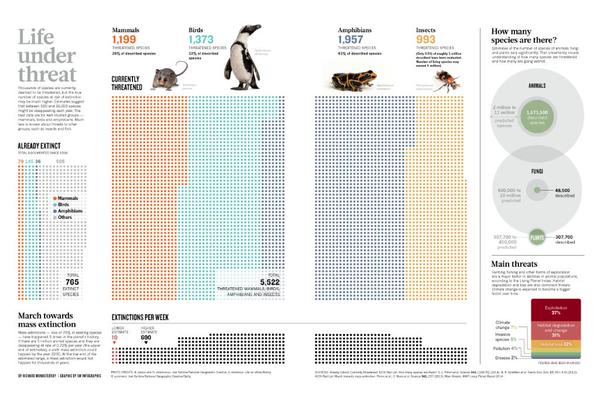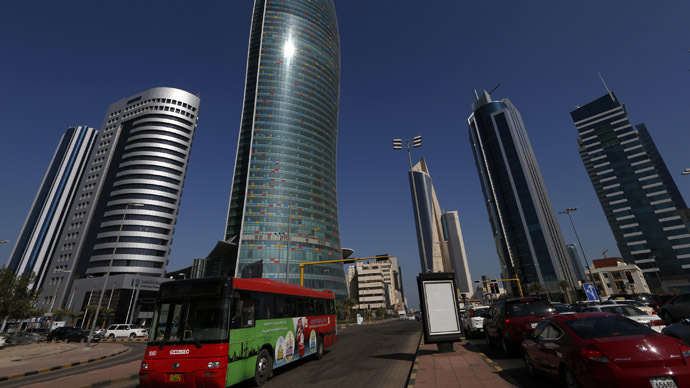![wildlife.si[1]](https://anonhq.com/wp-content/uploads/2015/02/wildlife.si1_.jpg)
Image: Reuters / Thomas Mukoya
Animals on Earth continue to disappear at an alarming rate which could result in another mass extinction over the next few centuries. A study by the log Nature claims that researchers are struggling to understand the scale of the problem.
The world’s wildlife populations, including mammals, birds, reptiles, amphibians and fish, have dropped by more than half in the final 40 years, the World Wildlife Fund (WWF) said in its latest report.
“Put another way, in less than two human generations, population sizes of vertebrate species have dropped by half,” Director General of WWF International, Marco Lambertini said in a statement.
The WWF released its Living Planet Index (LPI) report on Tuesday which is published every two years.
After measuring more than 10,000 representative populations of mammals, birds, reptiles, amphibians and fish between 1970 and 2010, WWF concluded that the populations of those species have dropped by 52 percent.
This year’s release marks a huge decline in comparison to previous report, which revealed a drop of 28 percent between 1970 and 2008.
Thousands of animals become extinct every year; pressures on species continue to grow, despite renewed conservation policies across the globe to try and slow the process, and the increasing amount of land and ocean areas being set aside for protection.
“We should feel a strong sense of urgency because we have to really deal with these issues in the next few decades,” Lambertini said. “We are using nature’s gifts as if we had more than just one Earth at our disposal. By taking more from our ecosystems and natural processes than can be replenished, we are jeopardizing our very future.”
“In general, the state of biodiversity is worsening, in many cases significantly,” said Derek Tittensor, a marine ecologist with the United Nations’ Environmental Program World Conservation Monitoring Center in Cambridge, UK, as quoted by Nature.
The so-called Red List of Threatened Species, compiled by the International Union for Conservation of Nature, discovered that there are 46,000 critically endangered species.
Thirteen percent of bird species are also in danger of being wiped off from the face of the Earth. Second in line are mammals, with 26 percent of species threatened. The report found that amphibians are in the greatest danger, with 41 percent of species known to be facing extinction.
The study blames the depopulation on modern farming methods and human interference with the habitat landscape of the most common bird species. Over 420 million fewer birds now reside in Europe than some 30 years ago, a new study has found.
Researchers say the bird population plunge has a direct link with modern farming methods which ruin and fragment natural habitats. They concluded that the number dropped from over two billion birds in the early 1980s to just 1. 64 billion in 2009. Scientists analyzed data about 144 types of European birds collected in 25 countries.
According to the study, published in Ecology Letters, 90 percent of the drop was recorded in the most common birds, such as sparrows, grey partridges, and skylarks.
“It is clear that the way we are managing the environment is unsustainable for many of our most familiar species,” said Richard Gregory of the Royal Society for the Protection of Birds, which co-led the study. “This is a warning from birds throughout Europe.”
“Common species are widespread and their numbers are linked to the deterioration of the quality of the environment on a landscape scale.”
“Significant loss of common birds could be quite detrimental to human society.” The loss these birds in Europe is concerning, as “it is this group of birds that people benefit from the most,” according to University of Exeter researcher Richard Inger.
Great titbirds, blue titbirds, robins, and blackbird populations are increasing, the study found. At the same time, the study points out that some rare bird populations have increased in recent years.
“The rarer birds in this study, whose populations are increasing, have benefited from protection across Europe. For example, white storks and marsh harriers receive among the highest level of protection in the EU – this is why their numbers have increased,” Gregory said, highlighting that legal protection is needed to reverse the decline in the populations of other species.
For example, fish, insects, and reptiles have not been adequately assessed. 7 million species that have been described by scientists, making a reliable threat level to groups difficult to determine. However, the study’s researchers examined just four percent of 1 percent. In terms of species, the biggest fall was reported among the populations of freshwater fish, down by 76 percent over the last four decades, the report stated.
Other countries that left one of many worst ecological footprints included Denmark, Belgium, Trinidad and Tobago, Singapore, Bahrain and Sweden. The report found that Kuwait had the worst record in the past four decades, with the most resources consumed and wasted per head of any country, followed by Qatar and the United Arab Emirates. The US also has a bad track record, with the report noting that “if we lived the lifestyle of a typical resident of the USA, we would need 3.9 Planets. Some of the poorer countries had better sustainability results, including India, Indonesia and the Democratic Republic of the Congo.”
Also, WWF said that the Earth has crossed three of out the nine identified “planetary boundaries,” which are “potentially catastrophic changes to life as we know it,” including biodiversity, carbon dioxide levels and nitrogen pollution from fertilizers. The loss of natural habitats, excessive hunting and fishing, as well as climate change were some of the main reasons behind the overall decline. Another two are currently in danger of being crossed: ocean acidification and phosphorus levels in fresh water.
Lambertini remains hopeful though, urging public and private sectors to act and search for ways to protect the environment. “Given the pace and scale of change, we can no longer exclude the possibility of reaching critical tipping points that could abruptly and irreversibly change living conditions on Earth,” the report said.
The upcoming generation can seize the opportunity that we have so far failed to grasp, to close this destructive chapter in our history, and build a future where people can live and prosper in harmony with nature,” Lambertini said.
“Things look so worrying that it may seem difficult to feel positive about the future. Difficult, certainly, but not impossible – because it is in ourselves, who have caused the problem, that we can find the solution.”
The main threats to habitats are human activity such as farming and hunting, as well as the possibility that climate change may accelerate the rate of extinction. Current estimates of the actual number of species on the planet range wildly, from two million to 50 million.
But extinctions are nothing new; more than 95 percent of all species have died off over the past 3. 5 billion years.
But the next one – unless something changes – is likely to be caused by human activity. Throughout history, there have been five mass extinctions caused by geological or astrological events such as ice ages or meteors.
Sources:
(Cain, George K., II. “Earth Could Face Another Mass Extinction â Study.” RT News. RT News, 16 Dec. 2014. Web. 09 Feb. 2015.)
(Crosby, Mary H. “Europe Has Lost 20% of Bird Population since 1980.” RT News. RT News, 04 Nov. 2014. Web. 09 Feb. 2015.)
(Williams, Kara. “Wildlife Populations Decline by over 50% since 1970 â WWF.” RT News. RT News, 30 Sept. 2014. Web. 09 Feb. 2015.)


![25.si[1]](http://anonhq.com/wp-content/uploads/2015/02/25.si1_.jpg)






I read this and cannot help but getting sad, why must we destroy our only home.
i dont see why the human race feels the need to continue to destroy and expand to make bigger city’s.. all we are doing is slowly killing ourselves
growth and sprawl is inevitable unless we stop the machinery that produces cheap goods of any sort
Do one thing 1 everyone,First learn and follow love to all living things,then there is no problem in the earth!
What do you expect when a single species overpopulate the planet at an unsustainable rate? You have to put people somewhere, you have to feed them. If you want to blame anyone, blame organized religion for preaching NO birth control to swell their numbers. Next blame the ignorant poor whose only outlet for enjoyment is sex without consideration for how to provide for the natural result of sex. Population control is really the only answer, how it is brought about is the problem. We must first recognize WE are the problem first…By then, it will be too late.
Who knows…maybe one of these other earthbound mammals pissed off the gods and they evolved man as retribution. LOL…I’d say that is a hell of a punishment.
There is but one GOD Man invented religion !!!!!!!!!!!! Life is built on the backs of the poor. The gap between the haves and the have not is widening. There is more to life than BE HAPPY.
Well, you see, the problem lies within the way the Governments of the world are covering up Fukushima and the world has been at war since 1900. That makes for a bad neighborhood.
Humans think they are more important then any other living thing. They think that material and unrequired things they use in their life is worth more than a life of a cat, an elephant or a fly. This is untrue! How can a sinful human be more important than sinless mosquito? When a human hits a sheep with a car, and the sheep dies and car gets damaged, humans judgement is that a shepherd should pay the car-driver the damage. WTF?…wtf?